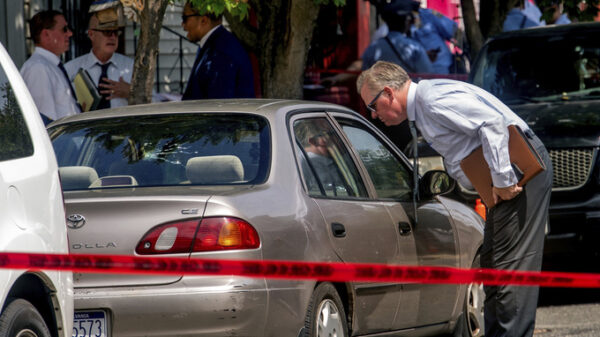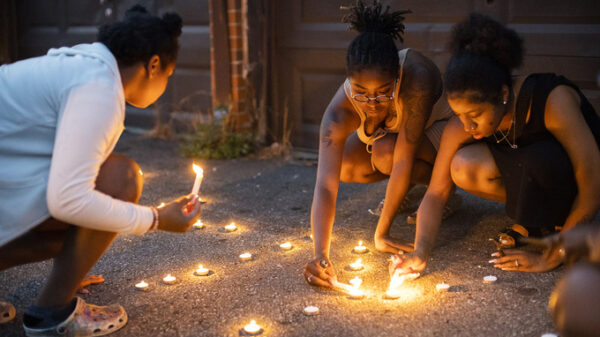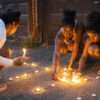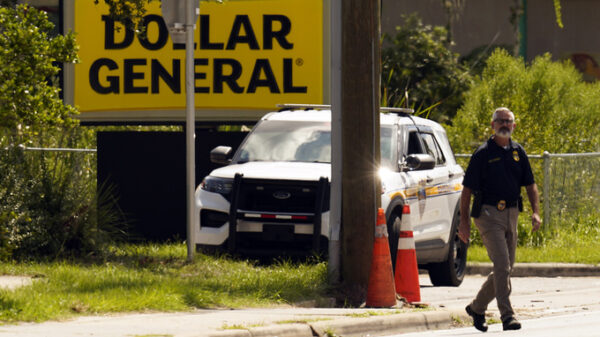A U.S. national flag tops a barricade delimiting territorial gang control in the Bel Air neighborhood of Port-au-Prince, Haiti, Saturday, Sept. 25, 2021. More than a city, Port-au-Prince is an archipelago of gang-controlled islands. Some neighborhoods are abandoned. Others are barricaded behind fires, destroyed cars and piles of garbage, occupied by heavily armed men. (AP Photo/Rodrigo Abd)
PORT-AU-PRINCE, Haiti (AP) —
Deported from the United States, Pierre Charles landed a week ago in Port-au-Prince, a capital more dangerous and dystopian than the one he’d left four years before. Unable to reach his family, he left the airport alone, on foot.
Charles was unsure how to make his way to the Carrefour neighborhood through a city shrouded in smoke and dust, often tolling with gunfire from gangs and police. On the airport road, the 39-year-old laborer tried unsuccessfully to flag down packed buses. He asked motorcycle drivers to take him but was told again and again that the trip was too risky.
Finally, someone agreed to take him as far as a bus stop.
“I know there are barricades and shootings,” Charles said as he took off into the unknown, “but I have nowhere else to go.”
This story is part of a series, Haiti: Business, politics and gangs, produced with support from the Pulitzer Center on Crisis Reporting.
At least 2,334 Haitians deported from Texas have landed here in the last week with $15-$100 in cash handouts and a “good luck out there” from migration officials — many setting foot in the country for the first time in years, even decades.
More than a city, Port-au-Prince it is an archipelago of gang-controlled islands in a sea of despair. Some neighborhoods are abandoned. Others are barricaded behind fires, destroyed cars and piles of garbage, occupied by heavily armed men. On Saturday, a local newspaper reported 10 kidnappings in the previous 24 hours including a journalist, a singer’s mother and a couple driving with their toddler, who was left behind in the car.
Even before the assassination of President Jovenel Moïse a in July, the government was weak — the Palace of Justice inactive, congress disbanded by Moïse and the legislative building pocked by bullets. Now, although there is a prime minister, it is absent.
Most of the population of Port-au-Prince has no access to basic public services, no drinking water, electricity or garbage collection. The deportees join thousands of fellow Haitians who have been displaced from their homes, pushed out by violence to take up residence in crowded schools, churches, sports centers and makeshift camps among ruins. Many of these people are out of reach even for humanitarian organizations.
Of the more than 18,000 people the United Nations counts among those displaced in Port-au-Prince since gang violence began to spike in May, the International Organization for Migration only has access “to about 5,000, maybe 7,000,” said Giuseppe Loprete, head of the IOM mission here. “We are negotiating access to the rest.”
This is the Port-au-Prince that awaits the deportees. Here are snapshots of a city that is far from welcoming.
Even before the assassination of President Jovenel Moïse a in July, the government was weak — the Palace of Justice inactive, congress disbanded by Moïse and the legislative building pocked by bullets. Now, although there is a prime minister, it is absent.
Most of the population of Port-au-Prince has no access to basic public services, no drinking water, electricity or garbage collection. The deportees join thousands of fellow Haitians who have been displaced from their homes, pushed out by violence to take up residence in crowded schools, churches, sports centers and makeshift camps among ruins. Many of these people are out of reach even for humanitarian organizations.
Of the more than 18,000 people the United Nations counts among those displaced in Port-au-Prince since gang violence began to spike in May, the International Organization for Migration only has access “to about 5,000, maybe 7,000,” said Giuseppe Loprete, head of the IOM mission here. “We are negotiating access to the rest.”
This is the Port-au-Prince that awaits the deportees. Here are snapshots of a city that is far from welcoming.
Elice Fleury didn’t pay much attention to the people running and shouting outside his bakery until he heard the bursts of gunfire. When he looked out the door on June 2, he saw heavily armed masked men pulling people out of their homes and taking control of his Martissant neighborhood.
The main road in Martissant is a strategic artery that connects the Haitian capital with the south of the country. The gang wanted control. They had surrounded the neighborhood that lies between mountains and the sea in a well-planned occupation, and were firing on the police station. When Fleury saw the officers fleeing instead of facing the armed men, he called his wife.
“I can’t get out,” she told him.
Fleury spent that night in a nearby square with other neighbors, talking to his wife by telephone — their children crying in the background — as she explained that the gunmen had fired tear gas, searched house by house and were patrolling the streets.
A day later, the family escaped, leaving everything behind, and reunited in a temporary shelter.
Three months later, the Fleurys languish in that temporary shelter, sleeping on the floor of a sports center a few miles from the house to which they neither can nor want to return.
Martissant has become one of the disconnected islands in the capital. Buses carrying people and merchandise from Port-au-Prince to the south of the country form convoys to travel through Martissant, often waiting for hours and sometimes overnight until they pay the gang members for clearance to travel, according to drivers.
Doctors Without Borders was forced to shut down its hospital in Martissant, where the agency had provided care for the last 15 years.
Seidina Ousseni, Head of the mission, describes the situation on the ground of Port-au-Prince in two words: “Urban warfare.”
Most of the city “in different degrees is facing the same circumstances,” Ousseni said. “Residents organize themselves to defend their neighborhoods and when they are not capable of doing it, they have to abandon the place.”
Two weeks after the Martissant attack, gunmen laid siege to an encampment called La Piste along the coast north of the capital, a neighborhood of deaf and disabled Haitians relocated there by the International Red Cross after the 2010 earthquake leveled the capital.
This time it was the police leading an assault at dusk, according to residents and a United Nations account.
“My son was playing cards outside when I heard the gunshots,” said Marie Jaquesmel, 70. “The police entered from different directions and started firing tear gas and shooting, we could only run.”
With 139 houses set fire behind her, she lost track of her 28-year-old son, who is deaf and cannot speak. “I don´t know if he is dead or alive, the only thing I saw is that those men were policemen.”
Now she is twice displaced, this time without her son to help provide food. She shares a cramped school with 315 families from La Piste, living in despair. Jaquesmel holds a photo of her son to her forehead and weeps. “Can you please help me find him?”
Joseph Dieu Faite, 56, a blind leader of the displaced residents of La Piste looks toward the horizon with eyes wide open, as if he were seeing a monster. The attack, he explains, was police retaliation against civilians living in a gang-controlled neighborhood.
“There were some gangsters there, I have to acknowledge that, but the police did not ask, did not say a word, did not make a difference, just evicted us and then took matches and gasoline and burned our houses one by one,” Faite said.
Justin Pierre June, 31, an articulate law student who arrived in Port-au-Prince on the first deportee flight last Sunday stood up to the IOM officers receiving them at the airport.
“This is not the right moment to deport us to Haiti. Haiti is not ready to receive deportees because its situation is chaotic,” he shouted. “This country is in a political, social, security and economic crisis, we are surrounded by gangs from all sides. … We should have been allowed to apply to become refugees”
More than 100 fellow deportees clapped in support. His sentiments were seconded 72 hours later by Philipo Grandi, the United Nations High Commissioner for Refugees, who questioned the US “mass expulsions of individuals…without screening for protection needs.” Grandi said that international law forbids the return of individuals to a country in such dangerous chaos.
The US has had a checkered history with the nation since Haitians freed themselves from slavery and French colonial rule at the start of the 19th century. Americans occupied Haiti for nearly two decades in in the 20th Century. Since then, through coups and earthquakes, US leaders and the international community have both contributed to chaos and tried unsuccessfully to rebuild the country.
All the while, Haitian immigrants made their way to US shores by sea to Florida or through Mexico to Texas.
On Thursday, the US Special Envoy to Haiti, Dan Foote, resigned, saying he could not defend a policy of deporting Haitians back to “a country where American officials are confined to secure compounds because of the danger posed by armed gangs to daily life.” The policy will backfire, he said: “Surging migration to our borders will only grow as we add to Haiti’s unacceptable misery.”
There could be as many as 100 gangs in Port-au-Prince; no one has an exact count and allegiances often are violently fluid. One of the most powerful groups is the G9 coalition of gangs led by Jimmy Cherizier, alias “Barbecue,” a former policeman turned gangster. His power seems to have increased since the assassination of the president last July, which he condemned, and there is even talk he may enter politics.
Downtown, Barbecue’s gang coalition controls the empty streets around the judiciary and legislative buildings, and all streets east to the coast. They open and close movement through the city center at will. Not far from the National Palace, residents of the adjoining Bel Air neighborhood don’t support Barbecue’s gang any more than they do the police, so they defend themselves against both.
Jean Baptiste Nevelson, 49, a spokesperson for Bel Air, nods toward the sea and G9’s territory and says, “We are afraid of the group down there, they put pressure on us every day.”
Nevelson, who holds no weapon but gives orders to some men who do, adds, “We do not trust any government, we do not trust the police. We only have ourselves … to be honest, we arrived at a point where this neighborhood can only be defended by our weapons.”
In half an hour of conversation, punctuated by several rounds of gunfire not too far away, he links the violence they are suffering to poverty and politics. “The state does not provide, we have no water, no schools, no electricity, no jobs. Many people used to go sell in the market and now they have been cut off by our enemies and cannot get there, so they stay here jobless. They are hungry.”
Gangs control access to and from the port — and, therefore, 80% of everything consumed in the island nation, according to port and business leaders. Merchandise coming out of the port is consolidated into convoys that must cross gang-controlled areas and face daily assaults as well as extortions. Sometimes groups of teenagers jump onto one of the trucks and cut the plastic, sending bags of cement and other goods to the street, where they are whisked away to houses.
The drivers don’t dare stop.
The wealthy of Port-au-Prince live in the hillside eastern suburb of Petion-Ville in gated and privately guarded homes, largely protected from the violence and cost of payoffs. But the poor suffer rising prices and bottlenecks. When food and fuel deliveries are stalled, prices rise and lines at gas stations grow into the hundreds.
In La Saline, in front of the main port entrance, a neighborhood partially burned by a gang two years ago, dozens of kids are barefoot, even naked, and beg for food and water. Warehouses and police stations have been looted. Traffic circles have burned tires and material piled up for barricades.
The city’s main food market, Croix des Bosalles, extends from the southern entrance of the port to the parliament, on ground where enslaved people were sold before independence. To enter the market today, one must walk through a gang gauntlet. First, one passes half a dozen young men with long weapons, phones in hand, earphones in one ear. Then, by a larger group sitting atop of the burned-out box of a trailer.
The floor of the market is thick with decomposing trash and, in some places, small fires of burning trash. Each footstep on the spongy ground seems to release fumes of decay into already fetid air.
Although the market is crowded, only about a third of the previous vendors and shoppers have been able to make their way out of their neighborhoods or through downtown to get there. The atmosphere is dense, angry, and full of resentment. Women alternately shout “go away from here,” or beckon an outsider to take a closer look: “How can a person live in these conditions?”
In a matter of minutes, a 30-year-old man dressed in black and dreadlocks identifies himself as “security” and offers a guided walk through areas that would not be possible to access without his company. Andy — he only gives one name — points to bananas, carrots, lettuce or lemon. They are sold from broken stalls or piles on the ground, not far from discarded chicken feet, entrails and empty plastic water bags. “Look at how we live in Haiti. The government has left us in this state. No human being deserves this. That’s why we have to organize ourselves,” Andy said.
His polite tour comes to an abrupt end when other “security” men approach and tell him to stop. His tone changes just as suddenly. “There could be an attack at any moment, you can’t be here, go away, go away, go away, go away.”
Indeed, it seems that violence can breakout at any time, in any random corner of the city. Angry mobs gather and dissolve, reunite and prepare for a new confrontation, while bystanders await the unexpected. They do not foresee a better life.
Nevelson, the Bel Air community leader’s prediction: “The future will be bad, chaotic, violent.”
Copyright 2021 Associated Press. All rights reserved.








































